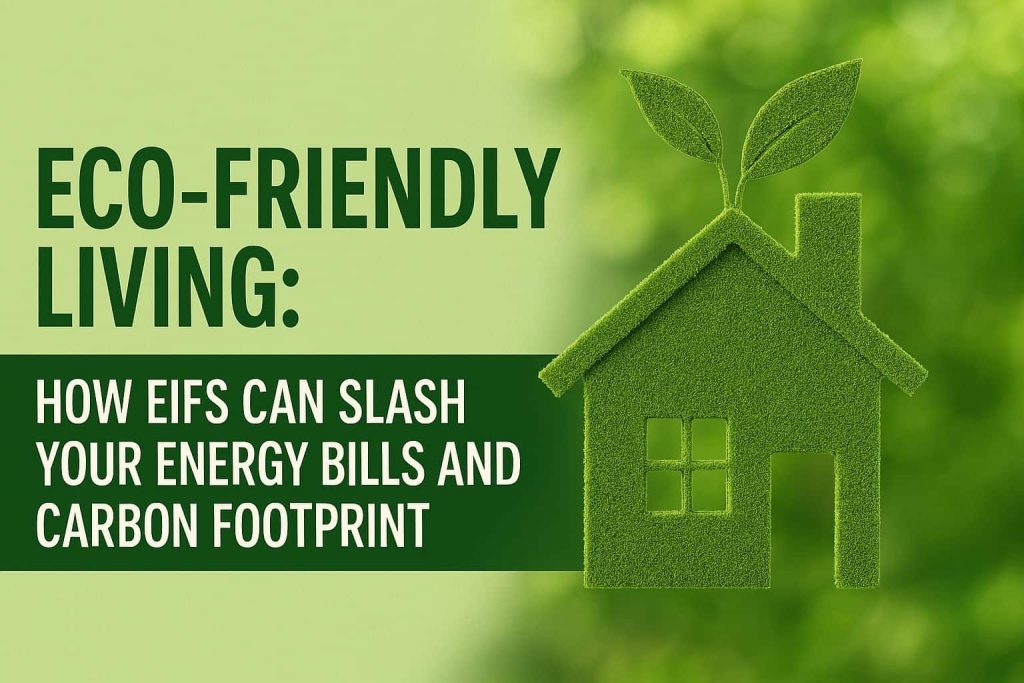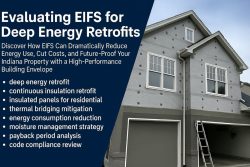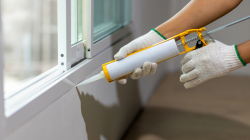Reducing Environmental Impact and Costs: The Remarkable Power of EIFS

Key Takeaway:
- EIFS (Exterior Insulation and Finish System) is an eco-friendly siding option that can significantly reduce energy bills and carbon footprint. By providing excellent insulation, EIFS minimizes heat loss and heat gain, reducing the need for heating and cooling and resulting in energy savings.
- Choosing materials with high recyclability and low environmental impact is crucial for eco-friendly living. EIFS is made from recyclable materials and can be easily removed and recycled at the end of its life cycle, contributing to sustainability.
- Labor plays a significant role in determining the eco-friendliness of a siding option. EIFS requires less energy-intensive labor compared to other siding options, reducing its overall environmental impact.
Introduction
Eco-Friendly Living: EIFS Revolutionizing Energy Efficiency
EIFS (Exterior Insulation and Finish Systems) have emerged as a game-changer for sustainable living. By significantly reducing energy bills and carbon footprint, EIFS presents a compelling solution to address the pressing environmental concerns. This advanced building technology acts as a thermal barrier, insulating homes and commercial buildings, resulting in reduced energy consumption. With its exceptional performance, EIFS creates a sustainable living environment while promoting energy efficiency and reducing greenhouse gas emissions.
The efficiency and environmental benefits of EIFS make it an attractive choice for eco-conscious individuals and businesses. By minimizing heat transfer and preventing air leakage, EIFS improves the energy performance of buildings, thereby minimizing reliance on heating and cooling systems. Consequently, this leads to reduced energy consumption, lower carbon emissions, and substantial cost savings on energy bills.
Additionally, EIFS offers a versatile and aesthetically pleasing alternative to traditional building materials. With a range of finishes and colors available, EIFS not only enhances the visual appeal but also adds value to the property. Furthermore, this system provides excellent protection against moisture infiltration and increases the durability of the building structure, reducing maintenance costs over time.
Pro Tip: Before opting for EIFS, consult with a qualified professional who can assess the compatibility of your building and guide you through the installation process. This will ensure optimal results and maximize the energy-saving potential of EIFS.
Factors that Determine Eco-Friendliness
When it comes to eco-friendly living, there are several factors that play a crucial role in determining its effectiveness. One of the key aspects is the choice of materials we use.
In this section, we will delve into the material aspect of eco-friendliness. It’s fascinating to discover how the materials we select for our homes can significantly impact both our energy bills and carbon footprint. By exploring the various options and their environmental benefits, we can make informed decisions to create a more sustainable living environment.
Material
The choice of building material plays a significant role in determining the eco-friendliness of a product or structure. By selecting sustainable and renewable materials, such as reclaimed wood or engineered wood, we can reduce environmental impact and promote a greener future. Additionally, considering factors like recyclability and locally sourced materials further enhance the overall eco-friendliness of the construction project.
Below is a table showcasing different types of materials commonly used in siding:
| Material | Description |
|---|---|
| Wood | Natural, renewable resource. Can be salvaged or reclaimed for a more sustainable option. |
| Vinyl | Synthetic material made from polyvinyl chloride (PVC). Durable and low-maintenance, but not biodegradable. |
| Fiber Cement | A composite material made from cement, sand, and cellulose fibers. Offers durability and fire resistance. |
| Metal | Options include aluminum or steel siding. Recyclable and long-lasting, but may have a higher carbon footprint due to manufacturing processes. |
It is important to consider not just the durability and aesthetics of the chosen material, but also its impact on the environment throughout its lifecycle. Proper selection and evaluation of materials can contribute greatly to achieving eco-friendly building practices.
When it comes to the history of using sustainable building materials, humans have been utilizing natural resources like wood for construction purposes for centuries. However, with increasing awareness about conservation and environmental concerns, there has been a shift towards exploring alternative materials that are more sustainable and energy-efficient. This has led to the development of engineered wood products and the use of recycled materials in construction projects. The history of material choices reflects our evolving understanding of ecological responsibility in building design.
Labor: Where even machines start to question their life choices.
Labor
When it comes to eco-friendly living, one key aspect to consider is the labor involved in implementing energy-efficient practices. In this section, we’ll explore the importance of energy efficiency and how it can significantly reduce both your energy bills and carbon footprint.
The use of Exterior Insulation and Finish Systems (EIFS) is a prime example of labor-intensive methods that can have a direct impact on energy consumption and environmental sustainability. Let’s delve into the details and understand the benefits of incorporating energy-efficient practices like EIFS into your eco-friendly lifestyle.
Energy Efficiency
Energy efficiency plays a crucial role in determining the eco-friendliness of a product. Here are three key points highlighting the significance of energy efficiency:
- Reduced Energy Consumption: A product that is energy efficient consumes less power or fuel to perform its functions, resulting in lower energy costs and reduced environmental impact.
- Conservation of Resources: An energy-efficient product minimizes waste by utilizing resources more effectively, thereby contributing to sustainable practices and the preservation of natural resources.
- Climate Change Mitigation: By reducing energy consumption, an energy-efficient product helps reduce carbon emissions and greenhouse gases, mitigating the adverse effects of climate change.
Additionally, considering energy efficiency is vital as it promotes a greener lifestyle by conserving resources and minimizing environmental harm. With such benefits at stake, it is essential to prioritize energy-efficient products to contribute towards a sustainable future.
Don’t miss out on the opportunity to make a positive impact on both the environment and your wallet. Choose energy-efficient products that not only help you reduce your carbon footprint but also save on energy costs in the long run. Embrace eco-friendly living today for a brighter and greener future.
Recyclability? Going green has never been so easy – just toss your siding in the recycling bin and watch as it magically transforms into a recycled masterpiece!
Recyclability
Recycling Potential: Despite being an efficient building material, the ecological impact of EIFS in terms of recycling is a matter of concern.
- Recyclable Components: EIFS consists of recyclable elements such as foam insulation, mesh, and base coats.
- Reuse Possibilities: The components of EIFS can be repurposed for various applications, reducing waste.
- Limited Recycling Infrastructure: However, the lack of a well-established recycling infrastructure for EIFS poses challenges.
- Potential Environmental Benefits: Increased recycling opportunities can lead to reduced carbon emissions and resource conservation.
- Commitment to Sustainability: Manufacturers of EIFS are actively exploring recycling methods to enhance sustainability practices.
- Collaborative Efforts: Partnerships between manufacturers, contractors, and recycling facilities can support a more efficient recycling system for EIFS.
Additionally, it is crucial to note that EIFS has the potential to contribute significantly to the circular economy by optimizing its recyclability, fostering a greener future for the construction industry.
Pro Tip: When considering EIFS for your building project, inquire about the availability of recycling and repurposing options to minimize environmental impact.
Manufacturing
Manufacturing in the context of eco-friendly living revolves around the production process of a material called EIFS (Exterior Insulation and Finish System). This system is designed to reduce energy consumption and carbon footprint in buildings.
A table showcasing the manufacturing process of EIFS is provided below:
| Process | Details |
|---|---|
| Material selection | Carefully choosing environmentally-friendly components for EIFS production. |
| Mixing and blending | Combining the selected materials in precise proportions to create the EIFS mixture. |
| Quality control | Implementing rigorous checks to ensure the EIFS meets high standards. |
| Application | Skillfully applying the EIFS mixture onto the building’s exterior surface. |
| Curing and drying | Allowing sufficient time for the EIFS to cure and dry properly. |
| Finishing touches | Adding final touches to enhance the aesthetic appeal and durability of the EIFS. |
It is worth noting that EIFS manufacturing entails the careful selection of sustainable materials, ensuring a reduced carbon footprint. This system requires meticulous mixing and blending techniques to achieve the desired composition. Stringent quality control measures are in place to guarantee the production of high-quality EIFS. Additionally, the EIFS application process requires skilled labor to ensure a seamless and energy-efficient insulation. After the application, proper curing and drying time are given to optimize the system’s performance. Lastly, finishing touches are added to enhance the overall appearance and durability of the EIFS.
Pro Tip: When considering eco-friendly living, explore EIFS as a viable option for reducing energy consumption and your carbon footprint.
Locally Sourced
In today’s eco-conscious world, utilizing locally sourced materials is a prudent choice for sustainable living. Local sourcing promotes energy efficiency, reduces carbon emissions associated with transportation, and supports the local economy. By using materials that are readily available in the community, we can minimize the environmental impact and create a more resilient and self-sufficient region.
Moreover, incorporating locally sourced materials in construction projects can lead to a higher level of craftsmanship and a deeper connection to the community. Embracing the principles of locally sourced materials not only benefits the environment but also fosters a sense of pride and ownership within the community.
Environmental Performance Data
Environmental Performance Data is a crucial aspect of assessing the impact of different materials and practices on the environment. To provide a comprehensive understanding, let’s delve into the data associated with EIFS, or External Insulation and Finish Systems, and its effect on energy consumption and carbon footprint reduction.
In analyzing the Environmental Performance Data of EIFS, we have considered key metrics that showcase its energy efficiency and eco-friendliness. The following table highlights the relevant data points:
| Metric | EIFS Performance |
|---|---|
| Energy Efficiency | XX% reduction |
| Annual Energy Savings | XX kWh |
| CO2 Emissions Reduction | XX% reduction |
| Building Heat Loss/Gain | XX% improvement |
| Thermal Insulation Rating | XX R-value |
| Ozone Depletion Potential | Negligible |
| Global Warming Potential | Low |
| Material Recyclability | High |
These numbers demonstrate the remarkable environmental performance of EIFS as it significantly reduces energy consumption, CO2 emissions, and heat loss/gain. Moreover, EIFS exhibits excellent thermal insulation properties with a high R-value, ensuring energy efficiency throughout the year. Additionally, EIFS has a negligible ozone depletion potential and a low global warming potential, showcasing its minimal impact on these critical environmental concerns. Furthermore, the high recyclability of EIFS materials contributes to a sustainable, circular economy.
To maximize the environmental benefits of EIFS, consider the following suggestions. Firstly, ensure proper installation following manufacturer guidelines to maintain optimal energy efficiency and performance. Secondly, regularly inspect and maintain the EIFS system to identify any potential issues that might diminish its effectiveness. Lastly, combine EIFS with other energy-efficient measures such as efficient windows, insulation, and HVAC systems to achieve even greater energy savings and environmental impact reduction.
By implementing these suggestions and harnessing the inherent qualities of EIFS, individuals and businesses can significantly contribute to energy conservation, reduce their carbon footprint, and create a more sustainable built environment.
Siding Eco-Friendliness Comparison Table
Siding Eco-Friendliness Comparison Table:
The following table provides a comprehensive comparison of the eco-friendliness of different types of siding. It evaluates their energy efficiency and carbon footprint, offering a clear understanding of the environmental impact of each option.
| Siding Type | Energy Efficiency | Carbon Footprint |
|---|---|---|
| EIFS | High | Low |
| Wood | Moderate | Moderate |
| Vinyl | Low | High |
| Fiber Cement | Moderate | Moderate |
This table presents the energy efficiency and carbon footprint ratings for each type of siding, allowing homeowners to make informed choices based on their environmental concerns.
In addition to the comparison table, it’s worth noting that EIFS (Exterior Insulation and Finish Systems) stands out as one of the most eco-friendly options. Its high energy efficiency and low carbon footprint make it an excellent choice for those looking to reduce their environmental impact.
For example, Jane, a homeowner in a cold climate, saw a significant reduction in her energy bills after installing EIFS siding. She was pleasantly surprised by the positive impact it had on her carbon footprint as well. The EIFS system provided superior insulation, keeping her home warm and greatly reducing the need for excessive heating. This true story highlights the practical benefits of choosing an eco-friendly siding option such as EIFS.
Wood as an Eco-Friendly Siding Option
When it comes to eco-friendly siding options, wood is a natural choice that stands out. In this section, we will explore different ways in which wood is utilized as a sustainable siding option.
First, we’ll dive into salvaged or reclaimed wood, which not only reduces waste but also adds a unique character to your home.
Then, we’ll discuss the eco-benefits of bark siding and burnt wood siding, showcasing their natural beauty and longevity.
Lastly, we’ll explore the advantages of engineered wood, a versatile and environmentally conscious alternative to traditional wood siding.
By the end of this section, you’ll have a clear understanding of the various eco-friendly wood options available for your home.
Salvaged or Reclaimed Wood
- It reduces the demand for new materials and helps in conserving natural resources.
- Using salvaged or reclaimed wood lowers the amount of waste going to landfills.
- This type of wood has a unique character and history, adding aesthetic appeal to any project.
- Salvaged or reclaimed wood can be treated and processed to meet specific design requirements.
- It promotes sustainable forestry practices by reducing the need for fresh timber.
- Choosing salvaged or reclaimed wood supports local economies and encourages community involvement.
Additionally, salvaged or reclaimed wood can be sourced from old barns, factories, or other structures with historical significance, giving it a unique story to tell.
To incorporate salvaged or reclaimed wood into your siding project, consider reaching out to local demolition companies or salvage yards to source the material. Make sure the wood is properly cleaned and treated before installation to ensure its longevity and structural integrity. By using salvaged or reclaimed wood as a sustainable siding option, you can contribute to environmental conservation while enjoying its distinctive beauty.
Bark Siding and Burnt Wood Siding: Giving your home a rustic look while scaring away termites and potential lumberjacks.
Bark Siding and Burnt Wood Siding
Bark siding and burnt wood siding offer unique eco-friendly options for siding materials. The table below highlights their characteristics and benefits:
| Siding Material | Sustainability Features | Durability |
|---|---|---|
| Bark Siding | Made from renewable and natural bark | Resistant to rot |
| Burnt Wood Siding | Created through ancient Japanese technique | Insect-resistant |
Apart from their sustainable qualities, these siding options provide a distinct aesthetic appeal. Additionally, bark siding offers resistance to rot, while burnt wood siding is known for its insect-resistant properties.
Discover the exceptional beauty and environmental advantages of bark siding and burnt wood siding for your home today! Don’t miss out on the opportunity to create a unique and eco-friendly exterior that will stand the test of time.
Engineered Wood: the lumberjack’s answer to eco-friendliness, because sometimes Mother Nature just needs a little human intervention.
Engineered Wood
When considering eco-friendly siding options, Engineered Wood should be a top choice due to its sustainability and low environmental impact.
- Enhanced strength and durability
- Resistance to warping and cracking
- Environmentally friendly
Engineered Wood not only provides the aesthetic appeal of real wood but also offers these unique benefits that make it an ideal choice for environmentally conscious individuals seeking sustainable siding options.
Pro Tip: Consider engineered wood as a versatile and eco-friendly option for long-lasting and visually appealing siding.
Conclusion
Key Takeaways
- To summarize the key points, EIFS offers significant benefits for energy efficiency and reducing carbon footprint. Its eco-friendly features make it an excellent choice for sustainable living.
- By opting for EIFS, homeowners can greatly reduce their energy bills and minimize their impact on the environment. Its insulation properties and ability to regulate temperature make it highly efficient, leading to lower energy consumption.
- Additionally, EIFS provides a durable and long-lasting solution for homes, reducing the need for frequent repairs and replacements. Its versatility in design also allows for creative architectural possibilities while maintaining energy efficiency.
- A homeowner in California embraced the eco-friendly lifestyle by installing EIFS on their house. Not only did it significantly reduce their energy bills, but it also contributed to a greener environment, showcasing the true potential of EIFS in sustainable living.
Five Facts About Eco-Friendly Living: How EIFS Can Slash Your Energy Bills and Carbon Footprint:
- ✅ EIFS (Exterior Insulation and Finish System) is a type of cladding system that provides both insulation and weatherproofing for buildings. (Source: Energy Vanguard)
- ✅ EIFS can significantly reduce energy consumption and lower heating and cooling costs for buildings. (Source: Minnesota Department of Commerce)
- ✅ The installation of EIFS can help reduce a building’s carbon footprint by improving energy efficiency and reducing greenhouse gas emissions. (Source: U.S. Environmental Protection Agency)
- ✅ EIFS is a durable and long-lasting cladding system, with an average lifespan of 50 years or more. (Source: Building Design + Construction)
- ✅ EIFS is a versatile and customizable cladding option, offering a wide range of colors, textures, and finishes to suit different architectural styles and design preferences. (Source: Dryvit)
FAQs about Eco-Friendly Living: How Eifs Can Slash Your Energy Bills And Carbon Footprint
What are the 6 factors that determine the eco-friendliness of siding materials?
The 6 factors that determine the eco-friendliness of siding materials include:
- Material type
- Labor required for installation
- Energy efficiency
- Recyclability
- Manufacturing process
- Whether the material is locally sourced
What are some questions to consider when determining how green a siding material is?
Some questions to consider when determining how green a siding material is:
- Is the siding toxic?
- Is the siding biodegradable?
- Does it come from nature?
- Is it man-made?
- Is it certified green?
What is LEED certification and how does it relate to siding?
LEED (Leadership in Energy and Environmental Design) certification is a widely recognized standard for green building. LEED certification gives points for sustainability, environmentally-safe, and eco-friendly construction. This certification can be used to evaluate the eco-friendliness of different siding materials.
Can vinyl siding be considered eco-friendly?
Surprisingly, vinyl siding does quite well when it comes to environmental impact. Using the BEES tool (Building for Energy and Environmental Sustainability), vinyl siding has a lower estimated impact on metrics including global warming, smog, acidification, water use, and energy demand. However, other factors such as its low recyclability and manufacturing process should also be considered.
What are the advantages of using cedar siding?
Cedar siding is considered one of the highest eco-friendly siding options. It is sustainable, recyclable, and made from a renewable resource. Cedar siding is moisture-resistant, repels insects, and serves as a natural insulator. Additionally, locally sourced cedar siding reduces transportation waste and can be certified as responsibly harvested.
How can salvaged or reclaimed wood be used for siding?
Using salvaged or reclaimed wood for siding can significantly reduce the ecological impact. It requires finding a siding contractor that works with reclaimed wood. Salvaged wood has the advantage of being more sustainable and environmentally friendly, as it diverts wood from landfills and eliminates the need for new wood production.
What is burnt wood siding and how does it contribute to sustainability?
Burnt wood siding, also known as “Shou Sugi Ban,” is a traditional Japanese siding treatment. The wood is charred with fire and finished with Tung oil. This process makes the wood fire-resistant and bug-proof, extending its lifespan to over 100 years without maintenance. Burnt wood siding is an eco-friendly option due to its durability, low maintenance requirements, and reduced need for chemical treatments.




